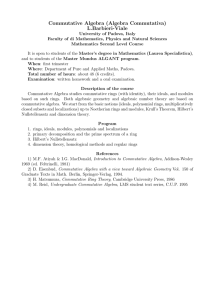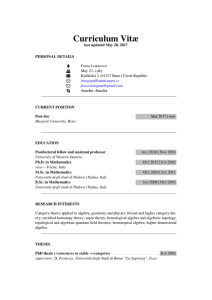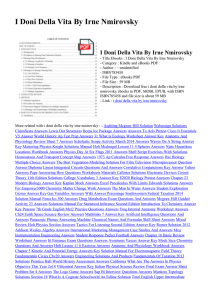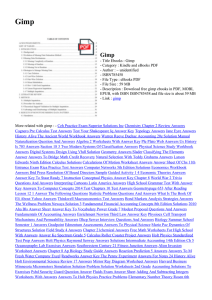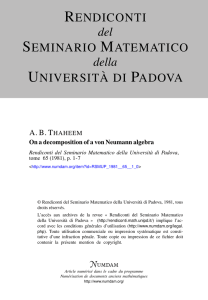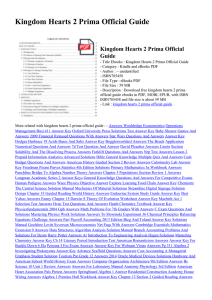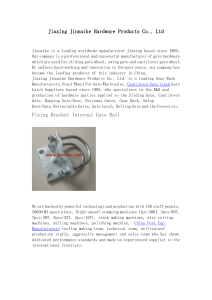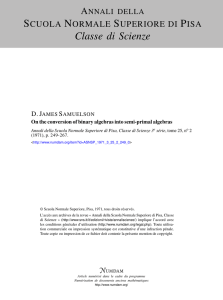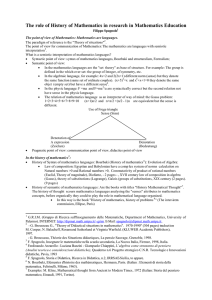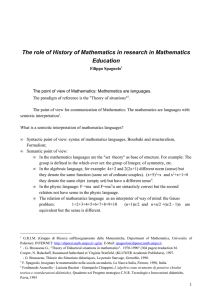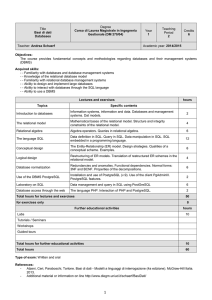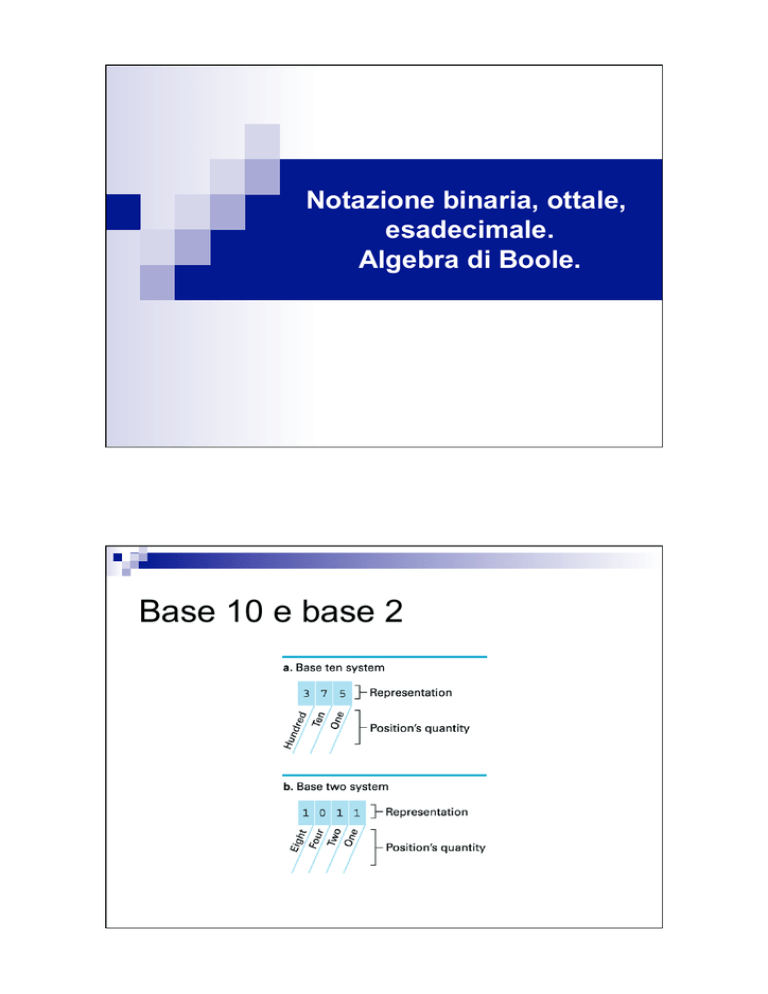
Notazione binaria, ottale,
esadecimale.
Algebra di Boole.
Base 10 e base 2
Rappresentazione decimale e
binaria
Base 10 è cifre da 0 a 9
n Base 2 è cifre 0 e 1
n Sequenza di cifre decimali
dk d k-1 … d1 d0
è numero intero
dk x 10k + dk-1 x 10 k-1 + … d1 x 10 + d0
§ Esempio: 102 in base 10 è 1x100+0x10+2x1
n
§
In generale:
Σ
(k=n,n-1,…,0)
dk 10k
Valore di una rappresentazione
binaria
• Per un numero binario dk d k-1 … d1 d0
• Stesso procedimento ma su base 2:
Σ
(k=n,n-1,…,0)
dk 2k
• Esempio:
01011012 = 1·25 + 1·23 + 1·22 + 1·20
= 32 + 8 + 4 + 1
= 4510
Valore di una rappresentazione
binaria
Rappresentazione binaria
§ Valore minimo di una sequenza di n
cifre binarie: 000 … 0 (n volte) = 010
§ Valore massimo: 1111…111 (n volte) =
2n-1 + 2 n-2 + … + 22 + 21 + 20 = 2n –1
§ Esempio con n=3: 111 = 22 + 2 + 1 = 7 = 23 -1
§ Da 0 a 8 (su 4 bit):
0
1
2
3
4
5
6
7
8
0000, 0001, 0010, 0011, 0100, 0101, 0110, 0111, 1000
Kilo, Mega, Giga, Tera, ...
n
n
Byte = 8 bit
Kilo, dal greco khiloi (1000 = 103)
¨
n
Mega, dal greco mega (grande)
¨
¨
n
¨
1.000.000.000 = 109
230
Tera, dal greco tera (mostro)
¨
¨
n
1.000.000 = 106
220 = 1.048.576
Giga, dal latino gigas (gigante)
¨
n
210 = 1024 = 1K (vicino a 1000)
1012
240
Peta, dal greco pente (5)
¨
¨
10005 = 1015
250
Notazione ottale (base 8)
n 8
simboli: 0, 1, 2, ..., 7
n Un simbolo per rappresentare ogni gruppo
di 3 cifre binarie (ce ne sono 8 diversi)
n Es.: 101101010011 (binario)
101 101 010 011
5
n Di
¨
5
2
3
5523 (ottale)
solito lunghezza multipla di 3
Es.: 3 simboli per 8 bit
Notazione esadecimale
n 16
simboli: 0, 1, 2, ..., 9, A, B, ..., F
n Un simbolo per rappresentare ogni gruppo
di 4 cifre binarie (ce ne sono 16 diversi)
n Es.: 101101010011
n Di solito lunghezza multipla di 4
n Es.: 3 simboli per 12 bit
Notazione esadecimale
• Es.: 101101010011 diventa
B53
this appendix, we suggest how these storage elements and circuits can be implemented
/2/09 in digital
4:28 logic,
PM specifically
Page 20-5
with combinational and sequential circuits.The appendix be-
BOOLEAN
gins with a brief review of Boolean 20.1
algebra,
which is the ALGEBRA
mathematical foundation of
digital logic. Next, the concept of a gate is introduced. Finally, combinational and
The gates,
digitalare
circuitry
in digital computers and other digital systems is designed, and
sequential circuits, which are constructed from
described.
-5
20.1
20-5
its behavior is analyzed, with the use of a mathematical 20.2
discipline
known as Boolean
/ GATES
algebra. The name is in honor of an English mathematician George Boole, who proposed the basic principles of this algebra in 1854 in his treatise, An Investigation of
BOOLEAN ALGEBRA
the Laws of Thought on WhichAlgebraic
to Found the Mathematical Theories of Logic and
Graphical
Symbol
Truth Table
Name
Probabilities.
In 1938, Claude Shannon,
a research assistant
in the Electrical EngiFunction
neering Department at
M.I.T.,
suggested that Boolean algebra could be used to
20.2
/
GATES
The digital circuitry in digital computers and other digital systems is designed, and
A B F
solve problems in relay-switching circuit design [SHAN38].1 Shannon’s techniques
its behavior is analyzed, with the use of a mathematical discipline knownFas!Boolean
0
0 0
A
•
B
A were subsequently used in the analysis and design of electronic
digital circuits.
algebra. The name is in honor
mathematician
George
Boole,
who pro- tool in two
AND of an English
0
1 0
F
Boolean
algebra
turns
out
to
be
a
convenient
areas:
or
Algebraic
Manipolazione logica 20-5
di bit
ame
B Boole
posed the
basic principles
of this algebra
in 1854 in(utile
his treatise,
Anla
Investigation
of di funzioni
Graphical
Symbol
Truth
Table
1 0 0 logiche):
n Algebra
di
per
specifica
Function
!
AB
• Mathematical
Analysis: It is an
economical
way
of
describing the function of digital circuitry.
the Laws of Thought on Which to Found
the
Theories
of FLogic
and
1 1 1
B
Ffunction,Engi¨ 20.2
variabili
logiche
(binarie)
ethe
operazioni
logiche
/ GATES
• Design:
Given in
aA
desired
Boolean
algebraAcan
Probabilities. In 1938, Claude
Shannon,
a research
assistant
Electrical
B beFapplied to develop a
simplified
implementation
of
that
function.
0
0
0
neering
Department
at
M.I.T.,
suggested
that
Boolean
algebra
could
be
used
to
F ! A • B può prendere valore 0 (FALSO) o0 10 (VERO)
A
0
¨ una variabile
1
A designA[SHAN38].
Shannon’s
solve problems in relay-switching
circuit
0 1 Boolean
0 Ftechniques
F
algebra
makes use 0of 1variables
and operations.
or As with any algebra,
!
A
"
B
OR
F
1
B subsequently used¨
Algebraic
were
in the
analysis and
design
of
electronic
digital
circuits.
operazioni
logiche
divariables
base:
OR,
NOT
1 0AND,
0operations
this
case, the
and
are logical variables
and operations. Thus,
1 0 1
Truth TableB FIn
!
AB
Function
Boolean
algebra turns out to be a convenient
tool inmay
twotake
areas:
a variable
on1the
1 value
1 1 (TRUE) or 0 (FALSE).
1 1 The
1 basic logical operations
are
AND,
OR,
and
NOT,
which
are
symbolically
represented
by dot, plus sign,
A
B
|
R
A
B
F
A
B
|
R
A
B
F
• Analysis: It is an economical way of describing the
function of digital circuitry.
and overbar:2
A
|
R
A
F
0
0
0
0
0
0
F
!
A
•
B
!A a
•ADesign: Given a desired function, Boolean algebra can be applied to Fdevelop
Rfunction.
= AAAND
R = A AND
0 1 R = NOT A
!
" BB
A#B
F0 1 of0that
NOT
AF
F 0 1 1 A AND
simplified
implementation
or
or B = B
B
1 0
1
0
0
1
1
0
A
OR
B
=
A
+
B
F ! A#
FAs
! AB
with any algebra, Boolean algebra makes use of variables and operations.
20-5
ND
OR
F
1 1
FOT
AND
OR
F
1
2
FOR
re 20.1
F
1
1 1
1
NOTThus,
A = A
In this case, the variables and operations are logical variables and operations.
A B F
A
B
F
a variable may take on the value 1 (TRUE)
0 (FALSE).
basic logical
operaTheor
operation
ANDThe
yields
if both of its operands are
A true
F (binary value 1) if and only
0
0 1 are true. The unary
0
0
0
F
!
A
true. The operation
OR
yields
true
if
either
or
both
of
its
operands
tions are AND, OR,n andOperatori
NOT, which A
arebooleani
symbolically
represented
by
dot,
plus
sign,
su due
variabili
0 1 consider
1
NAND
F 0the 1
! A " 2B
F0 1 1
operation
NOT inverts
valueFof!itsAB
operand. For example,
the equation
andFAoverbar:
or
B
1
0
1
1
0
1 0 1
F ! A#
Esempio: D = A + (B # C)
A AND B = A # B
1 1 0
1 1 1
A0 eB CF=D1.is equal to 0.
equal
if uguale
both
B
=
0
and
C
=
1.
Otherwise
A OR BD=isA
+ Bto 1 if A is 1Aor
DBè
a
1
se
A
è
1
o
se
B
=
F
Altrimenti
D
è
uguale
a
0.
0 0 1
A F NOT
0 0 1
AA = A
AF ! A
1
F
!
A
"
B
0 1 0
NOR
F
The
paper
is
available
at
this
book’s
Web
site.
F2 ! AB
1 Bvalue
0 1of its1operands are
F0 (binary
The operation
AND yields true
1) if and only if both
Logical NOT is often indicated by an apostrophe: NOT A = A¿. 1 0 0
B or
1 true
0 if either or both of its operands
1 0
1 The unary
true. The
OR yields
are true.
F !operation
A#
1 1 0
1 1 0 the equation
operation NOT inverts the value of its operand. For example, consider
A B F
A B F
A B DF = A + (B # C)
0 0 0
A
0 0 1
0 0 1
A
F
XOR
F!
A
!B
0 1 1
D is F
equal
to
1
if
A
is
1
or
if
both
B
=
0
and
C
=
1.
Otherwise
D
is
equal
to
0.
0 1 0
F0 1 1 BF ! A " B
! AB
1 0 1
B
1 0 0
1 0 1
1 1 0
1 1 0
A B F
A B F
M20_STAL3734_08_SE_C20.QXD
3/2/09 4:28 PM Page 20-3
0 0 0
0 0 1
A
F
F
!
A
!
B
0 1 1
F!A"B
0 1 0
B
0 1
1 0the
0 gate (known as the 1gate
signals through
delay). The significance of this delay is
1
1 0
1 1 0
The paper is available at this book’s
1 Web
1 site.
0
Logical NOT is often indicated
by an
apostrophe:
NOT
A = A¿.
Figure
20.1
Basic
Logic
Gates
Manipolazione logica di bit
discussed in Section 20.3. In some cases, a gate is implemented with two outputs, one
A B F
20.1 / BOOLEAN ALGEBRA 20-3
0 0 0
Table introduce
Operators
we
a common
term:
we say that to assert a signal is to cause
F ! A ! B Here
0 20.1
1 1Boolean
n Operatori
booleani
suOperators
due ofvariabili
(a)
Boolean
Two Input false
Variables(0) state to its logically true
signal line to 1make
0 1 a transition from its logically
NOT
P
P
Q
Q or
P NAND
Qdelay
P NOR
Q
Pdepending
XOR Q
1true
1 0(1)
gate (1)
(known
the
gate
delay).
The
significance
of
thisvoltage
isstate,
state.as
The
state
isAND
either
aP OR
high
low
on the
Basicoutput
Logic Gates
being the negation of the other output.
ugh the
(P)
(P # Q)
(P ! Q)
(P # Q)
(P + Q)
(P { Q)
P
Q
Section 20.3.type
In some
cases,
a gate
is implemented
with
of electronic
circuitry.
M20_STAL3734_08_SE_C20.QXD
3/2/09 4:28 PM Page
20-4two outputs, one
0
0
1
0
0
1
1
Typically,
not
all gate
types
are used
in implementation.
Design01 and fabrication
g the negation of the
other
output.
0
1
1
0
1
1
0
simpler ifterm:
onesay
of gates
are used.
Thus,
to identify
we introduce are
a common
thattypes
cause
1 only
0 we
0or two
0to assert
1 a signal
1is to
0it is important
1
1 its logically
1
0
1(0) state
1
0
0
functionally
sets
of gates.This
means
that 0any Boolean
function
can be impleo make
a transition
fromcomplete
he
gate delay).
The significance
this false
delay
is LOGIC to its logically true
20-4ofCHAPTER
20 / DIGITAL
mented
using
only
the
gates
in
the
set.
The
following
are
functionally
complete
sets:
e atrue
state is either with
a high
oroutputs,
low voltage state, depending on the
es,
gate(1)
is implemented
two
n Algebra
booleana:
postulati
e identità
Table
20.2
Basic Identitiesone
of Boolean
Algebra
tronic
circuitry. • AND, OR, NOT(b) Boolean Operators Extended to More than Two Inputs (A, B, . . .)
r output.
Basic Postulates
lly,
not
all
gate
types
are
used
in
implementation.
Operation
Expression Design and fabrication
Output " 1 if
#
#
A B = B is
A to cause
A + B = B + A
Commutative Laws
erm: we say that• to
assert
a signal
AND,
NOT
# C)All= of
A # (Bare
+ C) =used.
(A # B)A+ # (A
(Athe
+ B)
+B,C)...}
A
+ (B
B # C)
Á
AND
set# (A
{A,to
are 1. Distributive Laws
fitsonly
one
or
two
types
of
gates
Thus,
it
is
important
identify
logically false• (0)
to
its logically
true 0 + A = AAny of the set {A, B, ...} are 1.Identity Elements
A + B + Á
OR 1 # A = A
OR,state
NOT
complete sets of gates.This
means
that
any
Boolean
function
can be impleA# A =
0
A +
A = 1
Inverse Elements
#
a high or low voltage
state,
depending
on
A B # the
Á
NAND
Any of the set {A, B, ...} are 0.
•
NAND
Other Identities
g only the gates in the set. The
following are
functionally
complete sets:
NOR
A + B + Á
All of the set {A, B, ...} are 0.
0#A = 0
1 + A = 1The set {A, B, ...} contains an odd number of ones.
XOR
A{B{ Á
• NOR
sed in
implementation. DesignA # and
A = A fabrication
A + A = A
OR,
NOT
A # (B # C) = (A # B) # C
A + (B + C) = (A + B) + C
Associative Laws
gates are used. Thus, it is important
to identify A + B = A # B
A#B = A + B
DeMorgan’s Theorem
NOT
means that any Boolean function Several
can be
implepoints
concerning the notation are needed. In the absence of parenOT
the ANDsets:
operation takes precedence over the OR operation. Also, when no
The following are functionally theses,
complete
are stated without
proof, and other identities that can be derived from the basic postuambiguity
will occur, the
AND operation is represented by simple concatenation inlates.The postulates define the way in which Boolean expressions are interpreted. One
D
stead of
the
dot
operator.
Thus,
of the two distributive laws
is worth noting because it differs from what we would find
in ordinary algebra:
A + B # C = A + (B # C) = A + BC
A + (B # C) = (A + B) # (A + C)

